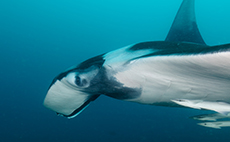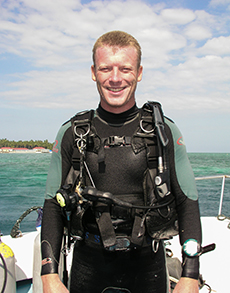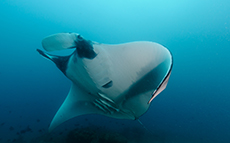




| Home | Features | Club Nights | Underwater Pics | Feedback | Non-Celebrity Diver | Events | 23 April 2024 |
| Blog | Archive | Medical FAQs | Competitions | Travel Offers | The Crew | Contact Us | MDC | LDC |

|

|
 
 |
    ISSUE 16 ARCHIVE - BEST DIVE, WORST DIVEGiles Winstanley is an experienced underwater photographer and marine biologist, currently working for the Marine Megafauna Foundation based in Tofo, Mozambique. As photographer for Pelagicon Underwater Imagery he has dived in a wide variety of conditions to help bring the appeal of the marine world above water and promote the need for marine conservation. After a period of teaching recreational diving both at home in the UK and abroad, the lure of using diving as a tool for both research and photography became too strong, so he taught himself underwater photography techniques, retrained as a marine ecologist, and endeavours to continue educating and inspiring marine conservation initiatives around the globe.WORSTEvery one of us divers knows there exists the potential for every dive to go wrong. We know that preparation is the key to avoiding problems, so we all like to believe we know how we’d react in a variety of unforeseen circumstances. The realisation that you’re not in control as much as you imagined, though, can come as a shocking surprise, as I found out a short time into one of the most captivating dives I’ve done, but also one that would reinforce a much warranted and enhanced level of respect for the forces of nature to which we’re all exposed. I was working as a resort cameraman based on Pulau Mabul in Malaysian Borneo, diving the infamous Pulau Sipadan daily, although this particular dive was a recreational one on a day off from work. Typically for Sipadan in March, the visibility was fairly good, particularly when compared to some conditions I’d previously dived in British waters, although I’d soon be reminded how such conditions can be deceptive. The dive started typically enough with a descent to about 40m to see what might be lurking lower on the reef. A few minutes passed without drama, soaking in the tranquility of tropical reef diving, when all of a sudden a magnificent sight loomed out of the blue: a wall of over a hundred scalloped hammerhead sharks, all swimming in schooling formation, gently swaying their tails to and fro, staying in perfect alignment with each other. Situated a little way off the reef and below us about 15 metres vertically, the rest of the dive group and I were unsurprisingly drawn in by this outstanding display, succumbing to the natural tendency to get a little closer. Inevitably we soon approached our no-decompression limit, pushing us to abandon our quest at depth, but what we were not fully prepared for was the current, that in just a few short minutes had made a dramatic shift in both direction and strength while we’d been so absorbed in the moment. On turning our backs to the sharks, we quickly realised we’d been swept away from the reef a fair way, along with a significant down-current developing. With every diver using a single tank and on the cusp of their decompression limit, the mind quickly fills with “what ifs”. What had initially been a relaxing and beautiful dive was now quickly becoming a challenge of physical endurance, panic avoidance, and group management. Kick after kick towards the surface, but none of us ascended. Breathing rates increased, minds raced, with the impending threat of the deep seeming to hold us tauntingly far from the surface. But through the oncoming risk of narcosis I soon came to the realisation that our best option was to swim sideways towards the seemingly distant reef, where the water would be flowing more slowly. Thankfully the strategy worked, finally making it back to the reef over what seemed like an endless period of time, although disturbingly over our decompression limits for what we’d planned, and still at 43m depth. We clambered up the reef slope towards our decompression ceiling, keeping a watchful eye on air, all eight of us realising we had probably just made an incredibly lucky escape. Astonishingly only a single diver ran out of air, forced to share with another throughout our unexpectedly long stay in the shallows. Suffice to say, however, that this experience helped to redefine my perspective of diving safety, particularly in deceptively idyllic tropical conditions. BESTAll divers have their reasons, some to plumb the depths of ancient wrecks after hours of scrutinising historical maps and preparing detailed dive plans, some to experience the sense of achievement in reaching unforeseen depths having practiced well-honed gas law wizardry, while for others it’s simply to stare in amazement at passing marine life to escape the virtual cage of office life. For me, there are two draws to the oceans as reliable as the tides: 1) to repeatedly experience the sense of immersive beauty derived from observing the day-to-day dynamics of marine life, and 2) to understand why marine creatures live and behave the way they do, along with figuring out how to use that for myself and others to continue experiencing the beauty. As a scientist I certainly value our inevitable reliance on the oceans for our very existence, yet my initial draw undoubtedly comes from simple aesthetics. Certainly photography helps enormously, as the very act of lifting the viewfinder to my eye usually implies I’ve encountered a visually pleasing and emotive subject, but as almost any actively diving marine scientist will attest (and yes, non-diving ones do exist), there’s nothing as inspiringly, skin-tinglingly refreshing as a first encounter with a sought-after marine creature. Having been diving since 1991 I’ve certainly had more than my fair share of new encounters, particularly as I make a point to put myself in situations in which they’re more likely to occur. However, nothing prepared me for 17th April of this year, which will surely be lodged in my memory for eternity. Manta Reef off the coast of Mozambique is renowned for regular sightings of manta rays throughout the year, and numerous people visit each year hoping to have a diving experience with the ocean wanderers. As a researcher for the manta ray project in the region, I’m well aware that both species, reef mantas and giant mantas, come to the reefs to visit cleaning stations, and that females make up the majority of those seen. However, throughout the nine years of the project’s lifespan, only a couple of pregnant giant mantas have been witnessed, and only a handful or two of sightings of recently mated females. Like most elasmobranchs (sharks, rays, etc.), during mating the male bites the females fins, and wing scars are the tell-tale sign for manta rays. The previous week or so of diving had left us all feeling a little disheartened, with few manta sightings, and a sense that they had ventured elsewhere. So you can imagine the heart-pounding exhilaration I felt when out of nowhere a female giant manta glided past me, and only centimetres from my face I saw distinct fresh wing scars near the tips of her wings, as they gently curled upwards when she rolled her belly towards me. Those who’ve dived with mantas will understand the experience of watching such pure grace swooping through the blue, yet to also know the rarity of that particular individual, brings with it a sense of humility and respect I’ve seldom experienced before in my life. Mantas also possess the largest brains for their body mass of any fish, so when she rolled her belly towards me, glided away, only to return to do the same once again, I almost started to believe that perhaps she might know that I was there to get photos of the spot patterns on her belly, which we use to identify each individual. As it happened, she was just one in a group of three giant mantas all visiting the site together, so the drought had well and truly been alleviated. Since then I’ve had numerous close encounters with other mantas, but none will stick in my mind as surely as this, with the knowledge that somewhere out there in the blue, the giant manta now known as Serendipity might be ready to produce another generation of graceful, gentle giants. |